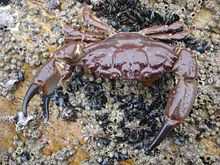Xantho hydrophilus
| Xantho hydrophilus | |
|---|---|
 | |
| Scientific classification | |
| Kingdom: | Animalia |
| Phylum: | Arthropoda |
| Subphylum: | Crustacea |
| Class: | Malacostraca |
| Order: | Decapoda |
| Infraorder: | Brachyura |
| Family: | Xanthidae |
| Genus: | Xantho |
| Species: | X. hydrophilus |
| Binomial name | |
| Xantho hydrophilus (Herbst, 1790) | |
| Synonyms | |
| |
Xantho hydrophilus (also known as Xantho incisus and various other scientific names) is a species of crab. It is yellowish-brown and grows to a carapace width of 70 mm (2.8 in). It is a nocturnal herbivore that lives in shallow marine waters from western Scotland to the Cape Verde Islands.
Description
The carapace of Xantho hydrophilus reaches a width of 70 millimetres (2.8 in),[1] and a length of up to 22 mm (0.9 in).[2] The antero-lateral edge of the carapace bears five blunt lobes.[1] It is yellowish-brown, except for the tips of the chelae, which are black.[1] X. hydrophilus closely resembles X. pilipes,[2] from which it can be distinguished by the absence of fringes of setae on the second to fifth pairs of pereiopods (walking legs).[1]
Ecology
Xantho hydrophilus lives under stones on sandy and stony beaches,[1] below the intertidal zone, up to a depth of 40 metres (130 ft).[2] It is a herbivore which feeds chiefly on various algae,[1] and is mostly active at night.[3]
Mating takes place in spring, and the females carry the fertilised eggs on their pleopods from March to July; the larvae can be found in the plankton over most of the summer.[1]
Distribution
Xantho hydrophilus is found from the Mediterranean Sea, the Cape Verde Islands, the Azores and the Canary Islands in the south,[2] north to the western and southern coasts of the British Isles, reaching its northern limit in western Scotland.[1] The populations in the Mediterranean Sea have been recognised as a separate taxon, initially as the subspecies Xantho hydrophilus granulimanus, but now generally as the species Xantho granulimanus.[4][5]
Nomenclature
| External identifiers for Xantho hydrophilus | |
|---|---|
| Encyclopedia of Life | 2950314 |
| ITIS | 98839 |
| NCBI | 342082 |
| WoRMS | 107440 |
Xantho hydrophilus was first described by Johann Friedrich Wilhelm Herbst in 1790, under the name Cancer hydrophilus. It was later described under the name Cancer floridus by George Montagu (1808) and under the name Cancer incisus by William Elford Leach (1814).[6] Confusingly, it has also been referred to by names of other taxa, such as Xantho poressa and Xantho pilipes.[3]
A crab species from the Indo-Pacific was described in 1834 as "Xantho incisus" by Henri Milne-Edwards; that species is now known as Lophozozymus incisus.[5]
References
- ↑ 1.0 1.1 1.2 1.3 1.4 1.5 1.6 1.7 J. D. Fish, Susan Fish (1996). "Arthropoda". A Student's Guide to the Seashore (2nd ed.). Cambridge University Press. pp. 329–412. ISBN 978-0-521-46819-0.
- ↑ 2.0 2.1 2.2 2.3 P. J. Hayward, John Stanley Ryland, ed. (1995). "Crustaceans". Handbook of the Marine Fauna of North-west Europe. Oxford University Press. pp. 289–461. ISBN 978-0-19-854055-7.
- ↑ 3.0 3.1 Sven Gehrmann (2008). "Steinkrabbe, Xantho hydrophilus (Herbst, 1790)". Die Fauna der Nordsee – niedere Tiere I: Krebstiere, Asselspinnen, Ringelwürmer, Stachelhäuter, Manteltiere& Schwämme [The Fauna of the North Sea – Lower Animals 1: Crustaceans, Sea Spiders, Annelids, Echinoderms, Tunicates & Sponges]. p. 87. ISBN 978-3-9812553-0-0.
- ↑ Michalis Mavidis, Michael Türkay & Athanasios Koukouras (2008). "The genera Atergatis, Microcassiope, Monodaeus, Paractea, Paragalene, and Xantho (Decapoda, Xanthidae) in the Mediterranean Sea". Crustaceana 81 (9): 1035–1053. doi:10.1163/156854008X360798.
- ↑ 5.0 5.1 Peter K. L. Ng, Danièle Guinot & Peter J. F. Davie (2008). "Systema Brachyurorum: Part I. An annotated checklist of extant Brachyuran crabs of the world" (PDF). Raffles Bulletin of Zoology 17: 1–286.
- ↑ Michael Türkay (2010). "Xantho hydrophilus (Herbst, 1790)". World Register of Marine Species. Retrieved January 12, 2011.